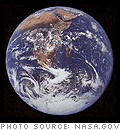New Planetary System

New planet has a mass 45 times that of Earth
by Liz Olson
 Related Links |
In 2007, scientists announced that they found five planets circling a star 41 light-years away from Earth in the constellation Cancer. It is the most extensive planetary system ever discovered and one that resembles our solar system. The first planet was detected in 1996 orbiting its star called 55 Cancri at a distance of 500 million miles.
Until 2007, there were four known planets orbiting 55 Cancri. A fifth planet was detected early in 2007 with a mass 45 times that of Earth. It orbits its star in 260 days at a distance of 70 million miles, which is roughly the distance of Venus from the Sun. The new planet may also have rocky moons orbiting it, but none have yet been spotted. It is unlikely that the moons could harbor life even if they do exist.
Although the newest addition to 55 Cancri’s solar system is located in the so-called habitable zone warm enough for liquid water, it is thought to resemble Saturn or Neptune with an environment uninhabitable for life.
Professor Debra Fischer of San Francisco State University led the team that reported this new planetary system. With the discovery, Prof. Fischer and her team have shown that our solar system is not unique in our universe, and with time and more data, it is possible for astronomers to find more planets that resemble Earth. In the last decade alone, 250 planets have been discovered orbiting around stars.
Scientists detect planets using a wobble technique that monitors the star’s light for variations that could be induced by the gravitational pull of orbiting planets. At first, scientists could only identify Jupiter-size planets, but with technological improvements they can now find planets only a few times the size of Earth.
There is an interesting 450 million mile gap between the new planet and the outermost planet. A similar gap exists in our solar system between Jupiter and Mars due to the disruptive effects of Jovian gravity on planetary formation. So far no other planets have been detected, but there is a chance that other planets could exist in the new planetary system’s gap. We can be certain astronomers will be closely monitoring the gap in the future.
- More from Space Exploration







